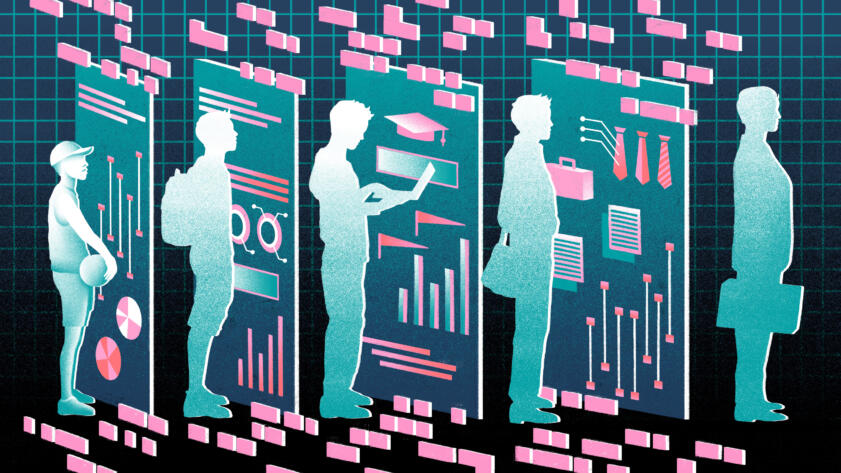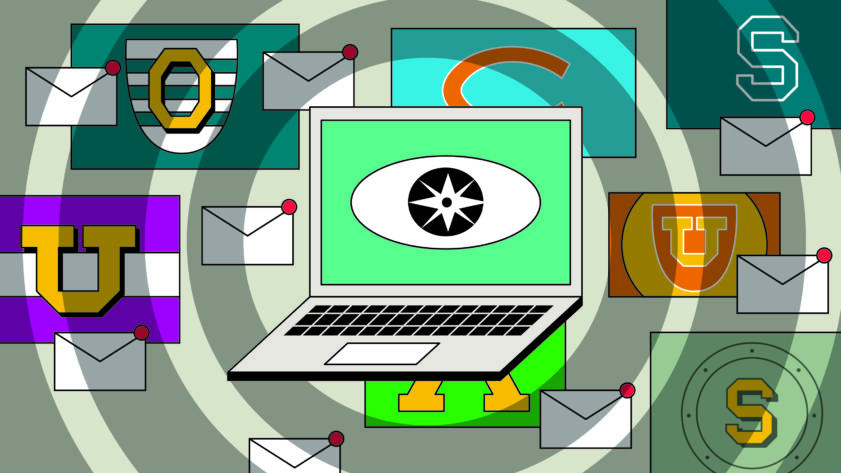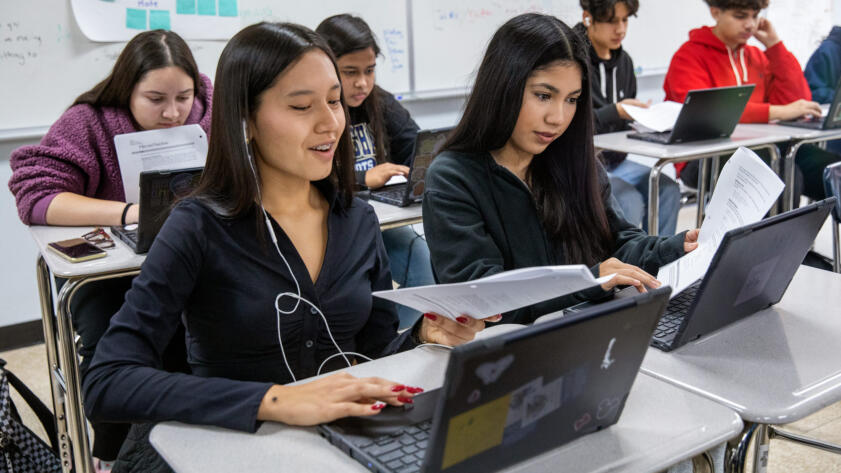The ed tech industry’s pandemic-era boom has meant K-12 schools and universities are receiving sales pitches for an abundance of new products—from generative AI writing tools and math tutors to robot security guards and lightboards. But with those choices, and billions of dollars being spent annually on ed tech, educators and school administrators say they also have a problem: There is no mandatory licensing process that certifies that ed tech products work as advertised or that they can be trusted with sensitive student information.
Experts have called for countries to establish licensing bodies for educational technology, but for the time being, ed tech companies have largely been left to regulate themselves through voluntary, industry-funded certification programs.

Machine Learning
This Private Equity Firm Is Amassing Companies That Collect Data on America’s Children
Vista Equity Partners has been buying up software used in schools. Parents want to know what the companies do with kids’ data
The result is that schools are using many products that may harm children. This week, the United Nations Educational, Scientific and Cultural Organization (UNESCO) released a report on global use of educational technology that warned, “Children’s privacy, safety and well-being are at risk due to lack of oversight of the education technology industry.” And last year a Human Rights Watch investigation found that many ed tech products endorsed by government agencies were potentially snooping on kids.
For example, Edmodo, one of the companies identified in the report, once had 10,000,000 estimated users. It went out of business last year and has since been fined by the Department of Justice and Federal Trade Commission for illegally collecting and storing data about users under the age of 13. (Somewhat confusingly, UNESCO at one point recommended Edmodo for distance learning.)
“We put more thought as institutions into buying tea bags than we do technology,” said Anne-Marie Scott, an open education advocate who previously led ed tech purchasing for universities in the U.K. and Canada. “We buy fair trade tea bags … and we buy utterly garbage proctoring systems.”
The Markup has reported on student privacy, algorithmic bias, and other harms that can stem from ed tech, and teachers, administrators, and parents have naturally wondered: So what ed tech is safe to use?
While we can’t recommend what products are right for an individual school, we spoke to educators, procurement officers, and parents to gather their best advice and recommendations for evaluating the myriad products on offer. Here are the four critical questions they said students, parents, and educators should be asking.
1. Will This Technology Help?
Experts, practitioners, and parents we spoke to agreed that a school’s first step in buying new technology should be to pause and ask whether the tech is needed. Is the newest software or hardware the most effective solution for the school? Sometimes—perhaps because a new tool is suggested directly by an educator or salesperson—this step gets skipped.
We put more thought as institutions into buying tea bags than we do technology.
Anne-Marie Scott, open education advocate
Holly Doe, director of technology for Maine’s Regional School Unit 40, said that she’s been shocked to learn how many different ed tech tools teachers in her small district started using during the pandemic. And the sales pitches haven’t stopped. “We get a lot of emails from vendors,” she said. “I’m flooded, flooded every day.”
She and Sarah Radcliffe, director of future-ready learning for the School District of Altoona, in Wisconsin, said that keeping detailed inventories of what products teachers use, how they use them, how often they use them, and when the contracts expire has helped the district assess what its schools actually need. Teachers could do this through a survey, or, unsurprisingly, schools can buy ed tech systems to help them evaluate how much they use other ed tech.
Both administrators also recommended that schools regularly survey their educators to ask how they’re using the products they have and what products they envision needing in the future.
2. Can I Get a Demonstration?
Scott, the former university technology officer, recommended that before a school begins a formal purchasing or request for proposal (RFP) process, it should examine the open source options available and then invite relevant vendors to demonstrate their tools for a group of educators, students, and IT staff. The demonstrations allow procurement officers to take note of what different products on the market can do and how they fit the specific use cases of the school’s community. With that information, the school can craft a more informed RFP and not wind up in a long-term contract for a product that ticked the boxes on paper but doesn’t meet real-world needs.
“I like to have students in the procurement team,” Scott said. “There’s nothing like a student sitting in the room to change the way a supplier talks about their product. They can’t rely on lazy stereotypes of what students are.”
Doe, from RSU 40, said she always tries to get demo samples of hardware or software licenses so that her teachers can pilot products before the district makes a larger purchase.
If you don’t actually experience it, I suppose you don’t really know.
Holly Doe, Maine Regional School Unit 40
“If you don’t actually experience it, I suppose you don’t really know,” she said.
Once a school has conducted its research, it should share that information with parents so that they too can understand and trust the technologies their children are using, said Cassie Creswell, a Chicago parent and co-chair of the Parent Coalition for Student Privacy,
“[Schools] need to share basic information with parents,” she said. “If they don’t, you can’t really have any confidence that they’re doing that due diligence to pick the contractor in the first place.”
The Parent Coalition for Student Privacy has created a toolkit to help parents get informed and involved in their schools’ technology decisions.
3. What Do the Reviews Say?
Once a school has decided it needs a new technology, it has to decide which specific product to purchase, often choosing from dozens of similar options.
Velislava Hillman, a visiting fellow at the London School of Economics and Political Science who researches ed tech procurement, said the lack of national licensing programs for ed tech makes it difficult for schools to know which products are tested and proven and which are snake oil.
Educators and administrators rely on peer networks to fill that information gap. But Hillman said there are two affiliated databases that share rigorous evaluations, benchmarking, and peer reviews of ed tech products:
EdTech Impact
This database is a partnership between industry, academics, and other experts that provides basic information about products (such as their compatible systems, pricing, and competitors) as well as standardized evaluations from school leaders on such questions as: Does the product improve educational attainment? Does it reduce teacher workload?
Education Alliance Finland certifications
This Finnish organization uses teacher reviewers to evaluate ed tech products on pedagogical criteria such as: What learning goals is the product intended to meet? Does it help students meet those goals? Does the product engage students in passive or active learning?
4. Will the Vendor Strengthen Its Privacy Commitment for You?
It can be hard to get the largest ed tech vendors to adjust their standard contracts on important issues like data privacy. But educators say it’s worth trying.
Doe said ed tech vendors are often “telling me what I need” rather than the other way around. “It can be really tough to get those big vendors to sign those [data privacy] agreements,” she added.
The answer, for RSU 40 and many other schools, has been to organize. In many regions, districts or universities have joined together to purchase ed tech products as a group, pooling their influence over potential vendors. RSU 40 and many other K-12 districts have also joined the Student Data Privacy Consortium and its associated state chapters.

Machine Learning
College Prep Software Naviance Is Selling Advertising Access to Millions of Students
The software, often required by schools, enables colleges and universities to choose from an array of demographics, including race, to target prospective students.
The consortium provides example data privacy agreements and hosts a database of vendors used by participating districts. Radcliffe, the future-ready learning director in Altoona, said some vendors will balk at signing a privacy agreement with a new district, so she uses the database to show them that they’ve already agreed to the same terms with other clients.
Creswell, the Chicago parent and advocate, said organized parents and students can also be effective when district officials aren’t.
She and other Chicago parents helped lead a successful campaign in 2021 that persuaded the district to amend its contract with College Board and other companies so that the vendors could no longer prompt students to agree to data sharing agreements (by clicking “Accept” on a website, for example) beyond what was allowed in the vendors’ contracts with the district.
“You shouldn’t be forced to hand over sensitive data in order for your kid to get a free, compulsory education,” Creswell said. “In most cases, you’re not really given an option to decline.”
The Growing Influence of Ed Tech
The need to scrutinize ed tech has exploded in recent years. In the school year before COVID-19 drove students out of classrooms and onto their devices, U.S. schools spent as much as $41 billion on educational technology, according to conservative estimates.
During the years that followed, the federal government appropriated an unprecedented $263 billion in emergency-aid funding for schools, who used much of it to purchase the technology necessary for remote learning. In response to the demand, global venture capital investment in ed tech companies tripled from $7 billion in 2019 to $21 billion in 2021 (before dropping to a more modest $11 billion last year).
Educators are clearly still cobbling together the resources they need to help ensure this is money well spent. They don’t have all the answers. But they at least have some good questions.
Correction, July 28, 2023
An earlier version of this story referred to the EdTech impact database as a partnership between industry and Norwegian academics. In fact, it is a partnership between industry, academics, and other experts.
Clarification, July 28, 2023
An earlier version of this story referred to two ed tech resources as organizations. It has been updated to refer to them as databases.





